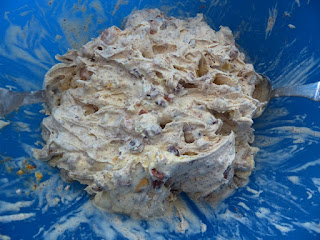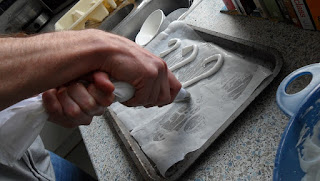The recipes: p96 of the former, "White Onion Soup"; p186 of the latter, "Basic White Bread"
An intervention takes place almost immediately this week. Not because there's a problem with the randomly chosen recipe - an onion soup sounds nice enough, even if there's something faintly offputting about the word "white" here - but because it's likely to be a bit, well, straightforward. I'm fine with conjuring up paragraph after paragraph about nothing much, but some content doesn't hurt, so a decision is made to go Full Lockdown and make some bread to accompany the soup.
Although it could be seen as an omen that the weekend omnibus of Come Dine With Me mocks me even as I'm putting the ingredients together.
Despite the lockdown, there are no sourdough starters being tended in this house - and indeed there's no flour other than plain white, so as much as I'd like to do something with wholemeal or (especially) rye, that'll have to wait for another time. Now you'd think it'd be easy enough to track down a recipe for a basic white loaf in one of my recipe books, but going through them at random - always on-brand, here - firstly throws up a bunch of sweet Swedish breads with cardamom or saffron involved, which, fine, but not today. Next book, and there's a couple of promising enough breads in there, but they all require a bread maker. One of them even requires the reader to look up the instructions for their bread maker and follow them. That's, um, not a recipe...?
Anyway, we eventually track down a white bread recipe in the pages of James Martin's Masterclass - which, while intended for a loaf, should make perfectly decent buns for dunking purposes. James is somewhat cagey about how easy this will be, concluding: "The best advice I can give you is to lock the door, turn on some music and spend a day practising." That approach might work for teenage boys on lockdown, but I've got a soup to make here, so I'm just going to get on with it and see how it all pans out. How hard can it be?
The prep: Like I say, for the bread I'm working with what flour I already have in the house. This is probably for the best since Lewisham Asda only has white flour in stock anyway - and no own-brand stuff, only Be-Ro, which I swear I haven't seen since the era of this cookbook. I've got some dried yeast in the cupboard already and it's only slightly past its best-before date, so that's fine. Can't be too choosy when there's a lockdown on. Otherwise we're grand on the bread front.
Onions are no problem either - we get a weekly veg box delivered, of course we have too many onions - so all I really need to buy in is some single cream (to deliver the titular whiteness), some fresh parsley, and some white wine. I don't even dare suggest using some of Sam's weekly sauv blanc ration for a purpose as frivolous as cooking, so I grab a Diane Abbott portable special instead, and we're ready to go.
 |
| Zylindrisch. Praktisch. Gut. |
The making: Between the proofing and the baking, the bread is going to need about two hours, so I start with that. Flour, dried yeast, salt, olive oil and warm water are mixed into a soft dough and kneaded for 10 minutes "until smooth and elastic", then left for an hour to rise and double in size. I then shape the dough into the smaller buns I'm going to be baking (for less long than the loaf recipe says, obviously), and they get another 30 minutes on a baking tray to rise a bit more. They also demand a dusting of flour before they go in the oven, which seems a bit superfluous to me, but who am I to argue with a Masterclass?
(Hey, I never said they were going to be geometrically sound. They're only dunkers.)
Meanwhile... well, shit. It's only now that I notice the "1 hour 40" preparation time on the soup. Seriously? For some onions floating in water? Gah. Well, OK. This is entirely my fault for not reading things properly before I started, and the bread will probably survive a slightly longer proofing than it needs, so best get the paring knife out and whip up some oniony tears before any real ones form.
I begin by finely slicing three medium onions and adding them to a pan along with some butter, some olive oil, and "one" clove of garlic.
The onions are cooked over a low heat for 30 minutes with the lid on, then for another 30 minutes with the lid off. The idea is to sweat and steam them first then gradually cook off the moisture so that the onions are "greatly reduced, but still very pale". I'm not convinced about the "very pale" part, but they're certainly reduced and nicely gloopy by this stage.
The white wine is added to this onion base - I give it a quick go on a high heat to burn off some of the booziness straight away - and some chicken stock follows, because it couldn't be a vegetarian onion soup, could it? A further half-hour of simmering later, and we're finally ready for the last stages. These involve removing half of the soup, blending it until smooth then returning it to the pan - an instruction I interpret as "use a hand blender in the pan, just for half as long as you would normally" - then adding the single cream, a spoonful of sugar and a fistful of chopped parsley, and heating it all through until it's ready to serve.
Which it is, along with the bread rolls that I've finally got round to baking in the meantime. They look nice enough, albeit misshapen (and that flour on top is still pointless).
 |
| Let's call them "rustic" |
The eating: The trouble with recipes that call for slow cooking, the thing I really, really hate about slow cooking... is that it works.
The soup is seriously good, and as much as my lazy soul would like it to be the case, you can't replicate that sheer depth of flavour by giving the onions a quick five minutes on a high heat. Although the addition of wine and cream doesn't exactly hurt on the flavour front.
 |
| Still impossible to photograph appetisingly though. |
The whiteness of the soup is more of a creamy golden yellow by the time everything's been added, which is probably for the best, because it was starting to feel like a MAGA rally around here. The bread rolls, however, are undeniably white and - as I feared when I had to let them prove for longer than I'd have liked - a bit stodgy and unsatisfactory. (Apparently not everyone can do homemade bread after all.) Still, with butter added while still warm, they're more than good enough for mopping up what little of the soup is left in the bottom of our bowls. I just wouldn't necessarily serve them up to anyone I was trying to impress.
So what have we learned? Mainly "when life gives you something simple, don't make matters difficult by overcomplicating things, fucko". Oh, and read the recipe first. Nice soup though.
Two-word verdict: Deep, man.






















 The book: Everyday Novelli (Jean-Christophe Novelli)
The book: Everyday Novelli (Jean-Christophe Novelli)






















